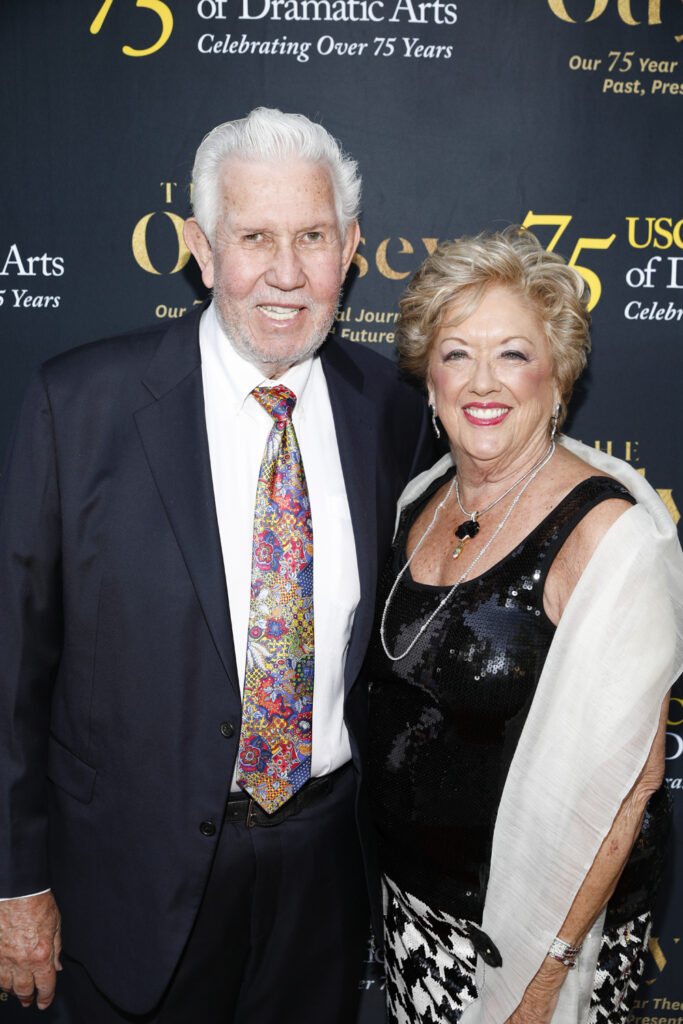In 1948, a building at the south edge of campus that was a relay station for the Red Line streetcar was turned into a theatre for USC’s growing drama department. It was named Stop Gap Theatre, and for decades, was a much-loved venue where students were encouraged to develop new productions.
Michele Dedeaux Engemann (BA ’68) remembers every detail of that theatre, which was torn down in 1990. “It smelled of dust, of greasepaint, the gas and exhaust from the cars along Exposition, the paint and glue from the sets and the leather seats,” she recalls. “The dressing rooms were dismal, everything was old, and it was just wonderful.
“We accepted it for what it was and felt so blessed to be in there.”
She and her fellow classmates did all the behind-the-scenes tasks at the theatre—scrubbing floors, acting as dressers, operating the lights—and they encouraged and supported each other in their technical tasks as well as their acting roles.

“Stop Gap was about new pieces and adapting pieces, and getting the absolute most creativity we could out of each other and out of the program,” she says.
It was where they rehearsed productions that students took to the Edinburgh Fringe Festival, a life-changing experience that Michele took part in for three years. At the Fringe, students would act in four different productions daily for three weeks, as well as doing backstage work and selling tickets between shows. This was her schedule one summer: performing experimental theatre games at 4:30 p.m., playing Maggie in the drama Cat on a Hot Tin Roof at 7 p.m., playing Adriana in the musical The Boys from Syracuse at 10 p.m., and appearing in a cabaret at midnight.
It was a “priceless” experience, and several of her classmates parlayed that experience into strong careers in show business. Says Michele: “We started in little Stop Gap and some went on to great things in film and TV and theatre and directing.”
Michele, who literally grew up on campus as the daughter of famed baseball coach Rod Dedeaux, and her husband Roger have given generously to USC, both in their time and financial resources. Michele is a current USC Trustee, the founding chair of SDA’s Board of Councilors and was an integral advocate for establishing SDA as an independent school within the university.
Michele and Roger have helped to make the building that will be SDA’s new home a reality. Alumni support has been critical to the Drama Center project, and several alumni have made gifts to name “inspired spaces” within the building.
When Michele and Roger decided to give the naming gift for the cabaret theatre which will be located in the building’s courtyard level, Roger wanted it to be named for Michele. Michele, however, had another idea. “I thought the name needed to be more historical,” she explains. “My experience at the Stop Gap was something I’ve taken with me to everything I’ve done since – the years of children’s theatre, performing and directing, and working with the Pasadena Playhouse. All the ideas that were generated at Stop Gap, the camaraderie and team building, gave me a real appreciation of the art of theatre.”
She suggested naming it the Stop Gap and Dean Emily Roxworthy agreed. The new Stop Gap Theatre will be a place buzzing with student energy into the night. It will not only house cabaret and improv performances but also alumni readings, student ISPs and professional development events.

What’s in a name?
So, what was the origin of the Stop Gap name?
There are two schools of thought. One USC historian wrote that it was named after a theatre in Colorado that was located near railroad tracks. When a train came along, the actors would freeze on stage, waiting for the noise to subside, with their “stop” causing a “gap” in the action.
A second explanation came from the founder of the drama department, William Churchill de Mille, the older brother of Hollywood director Cecil B. de Mille. The older de Mille regarded the building as a “stop gap” until a better building was available.
The building became a “stop gap” for quite a number of years, and was finally demolished in 1990 for not meeting earthquake codes. It was located at the corner of Exposition Boulevard and Hoover Street, when Hoover Street ran all the way through campus.
The new Drama Center location on 34th Street, at the Hoover Street entrance, will put it in a prominent campus location and part of a performing arts corridor, sharing 34th Street with the USC Thornton School of Music, the USC Glorya Kaufman School of Dance and the USC School of Cinematic Arts.
“I’m hoping the new Stop Gap becomes a place all students will enjoy,” says Michele. “It should be a learning ground for young minds to experiment and make it their own.”
